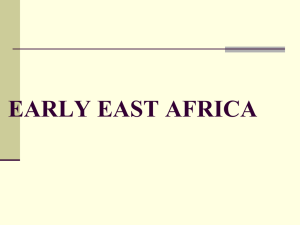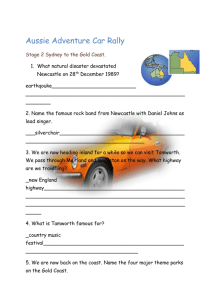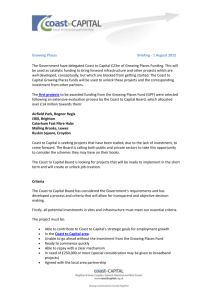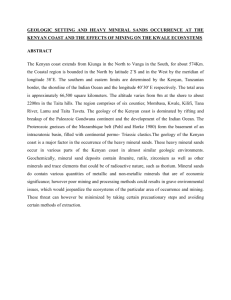CONTACTS BETWEEN EAST AFRICA AND THE - KCPE-KCSE
advertisement
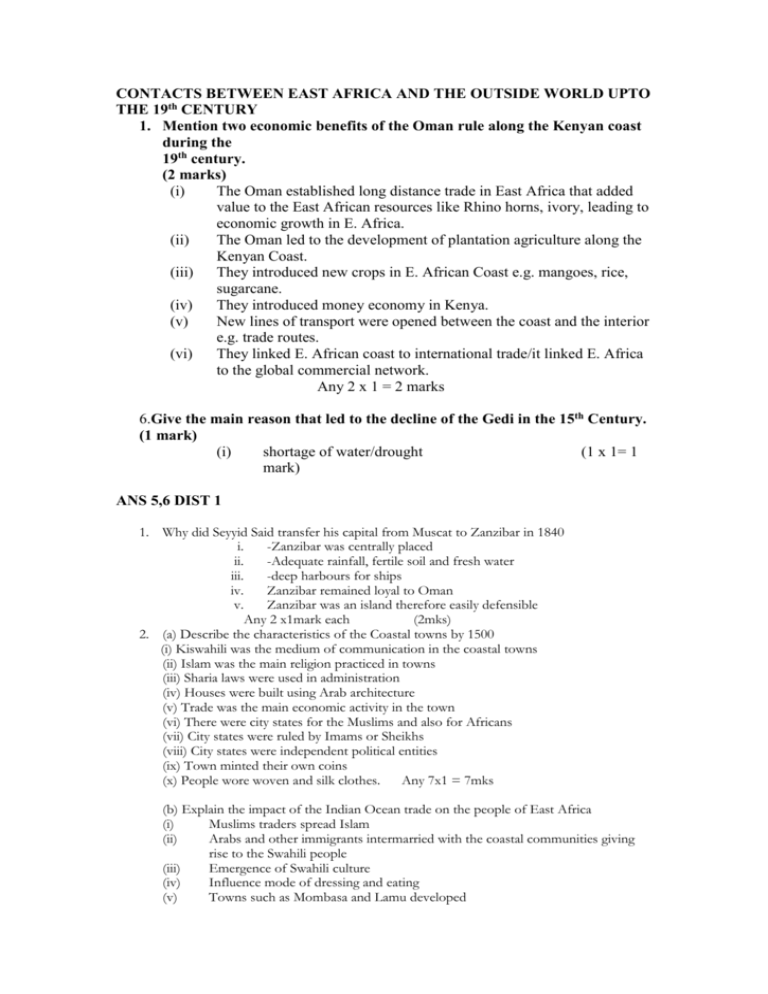
CONTACTS BETWEEN EAST AFRICA AND THE OUTSIDE WORLD UPTO THE 19th CENTURY 1. Mention two economic benefits of the Oman rule along the Kenyan coast during the 19th century. (2 marks) (i) The Oman established long distance trade in East Africa that added value to the East African resources like Rhino horns, ivory, leading to economic growth in E. Africa. (ii) The Oman led to the development of plantation agriculture along the Kenyan Coast. (iii) They introduced new crops in E. African Coast e.g. mangoes, rice, sugarcane. (iv) They introduced money economy in Kenya. (v) New lines of transport were opened between the coast and the interior e.g. trade routes. (vi) They linked E. African coast to international trade/it linked E. Africa to the global commercial network. Any 2 x 1 = 2 marks 6.Give the main reason that led to the decline of the Gedi in the 15th Century. (1 mark) (i) shortage of water/drought (1 x 1= 1 mark) ANS 5,6 DIST 1 1. Why did Seyyid Said transfer his capital from Muscat to Zanzibar in 1840 i. -Zanzibar was centrally placed ii. -Adequate rainfall, fertile soil and fresh water iii. -deep harbours for ships iv. Zanzibar remained loyal to Oman v. Zanzibar was an island therefore easily defensible Any 2 x1mark each (2mks) 2. (a) Describe the characteristics of the Coastal towns by 1500 (i) Kiswahili was the medium of communication in the coastal towns (ii) Islam was the main religion practiced in towns (iii) Sharia laws were used in administration (iv) Houses were built using Arab architecture (v) Trade was the main economic activity in the town (vi) There were city states for the Muslims and also for Africans (vii) City states were ruled by Imams or Sheikhs (viii) City states were independent political entities (ix) Town minted their own coins (x) People wore woven and silk clothes. Any 7x1 = 7mks (b) Explain the impact of the Indian Ocean trade on the people of East Africa (i) Muslims traders spread Islam (ii) Arabs and other immigrants intermarried with the coastal communities giving rise to the Swahili people (iii) Emergence of Swahili culture (iv) Influence mode of dressing and eating (v) Towns such as Mombasa and Lamu developed (vi) (vii) (viii) (ix) (x) (xi) (xii) Sharia laws were introduced Introduction of new crops e.g. wheat, rice and cloves A rich class of merchants emerged i.e chief kivoi, chief Ngonyo of giriama Local industries i.e weaving and iron working declined, because of importation of foreign goods Demand for slaves increased warfare leading to insecurity, loss of life and property destruction Development of trade routes in the interior East Africa coast was opened to the outside world leading to colonization. 8 points x 1mk each =8 mks ANS 3, 19 DIST 2 4. Two functions of the Orkoiyot among the Nandi - He foretold future events/seer - He presided over religious functions/Blessed the warriors - He advised the council of elders - He was a medicineman - He was a rainmaker Any 2 x 1 = 2mks 5. Two ways through which Islam was spread in Kenya by 1500 A.D. - Through contact with Arab traders/settler - Though intermarriage with the people of Kenya - Through building of Mosques in which the ideals of Islam were preached - Through madras/Muslim schools where Quran was the main text book - Through the use of Sharia laws in the administration of the city states - Through imitating the lifestyles of the Muslims Any 2 x 1 = 2mks 11. A part from the missionaries name two other groups that provided education in colonial Kenya - Colonial Government - Independent churches (African themselves) 2 x 1 = 2mks ANS 4, 5, 11 DIST 3 - 4.Two Greco – Roman records on the E. Africa coast Periplus of the Erythrean Sea Ptoleny’s Geography Natural History 5.Two negative effects of Indian Ocean trade on the Kenyan people Decline of local industries Intensification of inter-community warfare Colonization Destruction of wildlife 1 x 2 = 2 Marks 17.a. Three factors that led to the abolition of slave trade in E. Africa 3 Marks - Use of machines which were more efficient and reliable than human labour - Argument by economists e.g. Adams Smith that free people were more willing to work than slaves - Industrialization in Europe where raw market for European manufactured goods - Humanitarians saw it as against human rights 1x 3 = 3 Marks b. Six positive consequences of long distance trade 12 Marks - It stimulated local and regional trade - Foreign goods found their way to the interior - Introduction of new crops e.g. bananas, sugar cane etc to the interior - Emergence of class of wealth merchants e.g. Chief Kivoi - Development of trade routes - Development of market centres e.g. Mbooni hills - Development of plantation farming because of use of slaves - Introductions of money economy - Islam and Swahili culture spread to the interior 2 x 6 = 12 Marks ½ a mark if examples are not given as in the marking scheme/ any other relevant example ANS 4, 5 ,17 DIST 4. 3. - Used as a watch tower - It was an administrative centre - Areas of keeping of ammunitions / weapons - Hiding place - Kept war captives - Where they sent their expeditions from (any 2 x 1 = 2mks) 17. a) - Availability of trade goods - Demand for goods - Existence of rice merchants - Presence of trade winds/ monsoon winds - Peace and political stability at the Kenyan coast - Accessibility of the coast by deep sea harbours - Existence of local trade (any 5 x 1 = 5mks) b) - Establishment of towns like Mombasa and malindi - Intermarriages between Asians and African communities - Development of Kiswahili language - Spread of Islamic culture - Stimulated local trade - Stimulated commercial activities in the interior - Rivalry between different communities over the control of the region - Establishment of Arab rule / Sharia law - Rise of slave trade - Rise of merchants / rich people - Establishment of Islamic learning / teaching (5 well explained x 2 = 10mks) ANS 3,17 DIST 5 5. Identify one commodity that was imported from China to the Kenyan coast during the Indian Ocean trade (1mk) Porcelain bowls Daggers Swords Potter Silk Beads Glass ware 1 x 1 = 1mk 19. a) State three reasons why the Omani Arabs appointed local Arab families to control the East African coast on their behalf after defeating the Portuguese (3mks) They were civil wars in Oman They feared rebellion by coastal towns The Persians threatened to conquer Oman 3 x 1 = 3mks b) Explain the results of the development of plantation agriculture on the East African coast by Seyyid Said (12mks) It led to increased slave trade for slave labour Introduction of new crops such as cloves, coconut and maize Development of towns like Malindi, pemba Promoted trade Growth of wealthy merchants among the Arabs and Swahili It led to depopulation in the interior as slaves were taken to work in farms at the coast’ The population of foreigners from Oman increased at the coast Slaves were expected to poor working condition and long hours of work. 6 x 2 = 12mks ANS 5, 19 DIST 6 3. Give reasons why thre Arabs migrated to the Kenyan coast before 1500 A.D. (2mks) i) To trade ii) To escape religious conflicts / civil wars iii) To spread Islam iv) For adventure / Exploration. (Any 2 x 1 = 2 mks) 4. Name two communities who were actively involved in the long distance trade in Kenya during the colonial period. (2mks) i) Akamba iii) Agiryama ii) Swahili iv) Arabs ( any 2x 1= 2mks) 5. Give two factors that caused conflict between the Omam rulers and Mazrui of Mombasa ( 2mks) i) Oman rulers wanted to expand their potential influence over Mombasa. ii) Mazrui governors wanted to be independent. iii) Mazrui was aware of the civil wars facing Oman rulers back at home. Iv) Oman rulers wanted to control the Indian ocean trade. ( any 2 x 1 = 2 mks) 6. Identify two contributions of John krapf to the spread of Christianity in Kenya. ( 2 mks) i) He built a church at Rabai ii) He translated the bible to Kiswahili. iii) Trained catechists who assisted in the spread o the gospel. iv) Encouraged missionaries to come to Kenya. v) He did exploration work which led to the opening up of the interior of Kenya. ( Any 2 x 1 = 2 mks) 17. a) State five features of the coastal city states by 1500 A.D ( 5 mks) i) Kiswahili was used as the main medium of communication ( 5 mks) ii) Islam was the main religion practiced in towns. iii) Islamic law/ sharia was used in administration. iv) Houses were constructed using Arabic architecture v) Trade was the main economic activity in towns. vi) The city state were generally divided in two sections, one muslim and other African. vii) The city state were independent political entities. viii) Towns minted their own coins /money ix) People wore woven and silk clothes. x) They practiced mixed farming. They grew bananas yams and coconuts. xi) They fished in the Indian ocean fish/ sea food was a major for part of their diet. ANS3,4,5,6,17 DIST 7 5. Name two Europeans countries that rivaled the Portuguese for the control of the Kenyan coastal trade in the 17th century (2mks) -Britain -Dutch /Holland -France 20. Factors that led to the defeat of African coastal city states by the Portuguese in 1500AD -Portuguese had superior naval and military technology -Disunity of the coastal towns e.g. Malindi and Mombasa -Portuguese got reinforcement from their headquarter at Goa in India -The Turkish and Persian navies patrolling Indian oceans were weak. -Portuguese organized surprise attacks and fought with determination -Superior military tactics of the Portuguese. (5x1=5mks) b) Explain five factors that led to the development of long distance trade in Kenya in pre-colonial period -The external demand for goods from the interior e.g. ivory and animal skins. -Availability of items of traders from the interior -Demand for foreign goods in the interior e.g. cloth/ glassware etc -Presence of enterprising traders such as chief Kivoi of the Akamba. -Existence of well-developed local trade which formed a basis for long distance trade. -Presence of well-established trade routes between the interior and the coast. -Peaceful co-existence between the people of the interior and the coast. (5x2=10mks) ANS 5, 20 DIST 8 2x1=2mks 4. Give two roles played by the Arabs in the development of city states along the Kenyan coast. (2mks) i) They introduced new architecture of home building resulting to the growth of settlements ii) They built settlements and religious centres which evolved into towns / introduced Islam iii) They contributed to the development of trade which influenced the growth of towns. (1 x 2 = 2mks) 5. Give two roles played by the Arabs in the development of city states along the Kenyan coast. (2mks) i) Heavy taxation by the Portuguese ii) Corrupt / brutal / cruel Portuguese administrators iii) The Portuguese wanted to control trade a long the coast. iv) Coastal people were Muslims while the Portuguese were Christians (1 x 2 = 2mks) 6. Name two Christian missionary societies that operated in Kenya in the Nineteenth century (2mks) i) The church missionary society. ii) The white fathers iii) The African Inland mission iv) Church of Scotland v) The Holy Ghost fathers (1 x 2 = 2mks (use of abbreviations half mark each 19a) State three reasons why Seyyid Said transferred his capital city from Muscat to Zanzibar i) The climate in Zanzibar was pleasant as compared to Muscat which was hot and dry throughout the year/ green throughout the year ii) The need to control the town a long the East African coast more effectively. iii) Zanzibar had deep harbour which ships could anchor. iv) Zanzibar had a strategic position which was convenient for trade with the main land. v) Zanzibar had a fertile soil for the cultivation of cloves vi) Zanzibar had clean water for drinking 3x1 = 3mks b) Explain six effects of Sayyid said’s transfer of his capital from Muscat to Zanzibar on the Kenyan Coast (12mks) i) Expansion of coastal towns ii) Development of cloves plantation farming iii) Slave trade expanded/Zanzibar became a leading town in slave trade. iv) Expansion of trade by sending caravans to the interior, signing commercial treaties with representatives of the French, British, Germans and the Nyamwezi v) Exposed the interior of the East Africa to the outside world. vi) Expanded the spread of Islam to the interior. vii) Led to more Arab settlement at the Kenyan coast/the coast was effectively controlled by the Arabs. viii) He encouraged Indians merchants / panyans to Zanzibar. 6x2 =12mks ANS 4,5,6, 19 DIST 9 5. Identify one natural factor that facilitated the coming of the Arabs to the Kenyan coast (1mk) a) The monsoon winds b) Deep natural harbours along the Kenyan Coast Any 1x1 = 1mark 6. State one way in which the freed slaves promoted the spread of Christianity in Kenya. (1mk) a) They were trained as catechists and helped to spread Christianity among fellow Africans b) They were involved in charity work e.g. helping the poor, the sick and orphans hence enabled the missionaries to win the hearts of the Africans Any 1x1 = 1mark 18. a) What factors influenced Seyyid Said’s decision to transfer his capital from Muscat to Zanzibar (3mks) a. Zanzibar supported him during the war with Mazrui in Mombasa b. It had a deep water harbour c. It had clean water d. Its position was convenient for trade with Mombasa e. It had fertile soils for cultivation of cloves f. He wanted to use Zanzibar to effectively control the East African Coast g. Zanzibar was easier to defend Any 3x1 = 3marks b) Describe the effects of long distance trade in Kenya during the 19th century (12mks) a. It stimulated trade at local levels as goods were exchanged between communities living near the major trade routes b. Trade activities enhanced good relations between Kenyan communities c. There was cultural interaction and people copied other peoples culture e.g. Swahili and Arab culture d. Foreign goods spread to many parts of Kenya e. The Sultan of Zanzibar spread his influence in the interior of Kenya through trade f. Some traders became rich e.g. chief Kivoi and Ngonya of the Agiriama g. Introduction of money economy in Kenya h. New crops spread from the coast to other parts of the country i. Islam spread along the trade routes into many parts of the country j. Slave trading activities intensified leading to increased human suffering k. Trade centres developed into towns Any 6x2 = 12 marks ANS 5,6, 18 DIST 10 1. 2. i) Used as a watch tower . ii) Acted as a military base for sending expeditions iii) Acted as a store for fire arms / armaments vi) Used as a prison for captives v) As an administrative (2x1= 2mks) i) Ukambani area is dry/need for alternative means of acquiring food. ii) Their central position between the coast and the interior. iii) Availability of well established routes. iv) The Akamba had participated in local trade earlier. v) The existence of prominent leaders e.g. chief Kivoi. vi) Their skill in hunting and sem- nomadic life provided items for trade. 1 x 1 = 1mk) ANS 3,4 DIST 11 2. 4. – Were Christians - Wanted to rule themselves. - Portuguese were harsh in their administration - Portuguese had interfered in the Indian Ocean trade (Any 2x1=2mks) – Monsoon winds - Deep natural harbours - High seas which acted as highway. (2x1=2mks) 7. – Female genital mutilation - Polygamy (2x1=2mks17. a) - Availability of items of trade from East Africa e.g. gold, ivory and slaves. - High demand of trade items. - Enterprising merchants both at the Coast and outside East Africa. - Existence of local trade among the Africans. - Accessibility of the East African coast by sea/good natural harbours at the coast. - East coast enjoyed peace and political stability. - Advancement of ship building industry in Europe boosted the trade. - Existence of Indian Banyans (money lenders) who gave credit facilities for trade. (Any 3x1=3mks) b) – Intermarriages between Muslim traders and other foreigners with local Bantu communities. - Emergence of Kiswahili language. - Introduction of Islam, with new Islamic culture, way of dressing, architecture. - Introduction of Islamic Law (Sharia). - New crops were introduced along the Coast e.g. rice, wheat etc. - Development of towns as a result of profits from trade e.g. Mombasa. - Trade led to rise of a class of rich merchants. - Decline of local industries e.g. weaving. - Increase in demand for slaves and ivory. (Any 6x2=12mks) ANS 2,4,7, 17 DIST 12 1. Give two reasons why Said Sayyed moved his capital to Zanzibar in 1840. i) To control his east Africa dominion more effectively ii) Zanzibar was centrally located. iii) Zanzibar had cool pleasant climate compared to Muskat which was not and dry. iv) Zanzibar had sufficient rainfall /fertile soil which could support clove growing. v) Zanzibar had fresh water vi) Zanzibar had good harbours which was deep water and could be used as an international port for large vessels. vii) Zanzibar was strategic and Said Seyyid could use to control both local and international trade. Any 2x1 =2mks 2. Give one historical monument left behind by the Portuguese? i) Fort Jesus in Mombasa ii) Vasco da Gama pillar in Malindi 1x1=1mk 3. (a) Five reasons why the people of the east African coast were unable to resist the conquest of the Portuguese. i) Portuguese had superior weapons unlike the Africans ii) The Portuguese had well trained army compared to African ablebodies men. iii) Some African communities collaborated with the Portuguese thus being used too fight their fellow members. iv) Disunity among the costal towns, marking them not to unite against external forces. v) Surprise attack used by the Portuguese in the Africans. vi) Weakness of the Turkish and Persian navy which could not support their Muslim brothers. vii) Portuguese got reinforcement through Goa unlike the exhausted Africans Any 5points 1mk 5x1=5mks (b) Five effects of Indian Ocean trade on the east African people i) Africans were converted to Islam ii) Intermarriage occurred between the African and the Arabs iii)The intermarriage brought new society known as the Swahilis iv) The rise of Kiswahili language which become common language of communication. v) Insecurity brought about by raids due to quest for slaves. vi) Repopulation as slave trade thrived in the area. vii)New crops were introduced such as cloves maize. viii)Introduced Islamic law like sheria. ix) Islamic courts kadhi were introduced. x) Islamic way of dressing and eating was adopted by the coastal people. xi)Towns emerged on the coast as well as the interior. xii)Destruction of wildlife as demand for ivory intensified.Any 5 point 2mks (2x5=10mks) ANS 4,5,17 DIST 13 3.Identify any Portuguese who led in the expeditions of conquest in East Africa. (1mk) Vasco Da Gama Ruy Laurenco Ravasco Fransico D. Almeida Tristao da Cunha 1 x 1 = 1 mark 4.Name two missionaries who worked in Kenya by the 19th century (2mks) Johann Krapf Johann Rebmann Jacob Erhardt 2 x 1 = 2 marks 19.(a) Give five problems faced by the Omani rulers in East Africa. (5mks) The Omani rulers were harsh and ruthless and were thus hated by the coastal people. There was constant rebellion from the coastal towns. Civil wars back in their country Threats of Persian invasion to their countries. Were attacked by sea pirates along the Indian Ocean. 5 x 1 = 5mks (b) Explain five effects of long distance trade in Kenya during the 19th century. (10mks) Development of towns e.g. Mombasa, Lamu, Kilwa, Pembe. Intensification of both local and regional trade as new goods were introduced. Emergence of a class of wealthy African e.g. Kivoi of Ukambani, Ngonyo of Mjikenda, Msiri of nyungu ya mawe. Introduction of foreign goods e.g. beads, cloth and plates. New crops were introduced e.g. bananas, rice, sugarcane and mangoes. Introduction of Islam and Islamic culture by the Arabs and Waswahili traders. Led to the development of plantation agriculture in Malindi and Mombasa. There was development of trade-routes and market centres in the region. Development of a money economy that replaced barter trade. It led to colonization of East Africa since it gave reports about the coast its strategic and commercial ability. 5 x 2 = 10mks ANS 3,4,19 DIST 14 4.State two sources of rivalry between coastal city states. (2mks) – Trade - Taxation Enlarging their city states at the expenses of others. 17.(a) Account for the defeat of the coastal city states by the Portuguese. (5 mks) - Superior weapons/Naval and military technology. - Well trained soldiers. - Disunity and political rivalry of the coastal towns e.g. Mombasa against Malindi. - Reinforcement the headquarters at Goa. - Used to suppress attacks/attacked without warning. - They were brutal, cruel and ruthless. - They burnt and rooted. - Coastal city states were not assisted by the Persians who had weak armies. 5 x 1 = 5mks (b) Discuss five positive consequences of the long distance trade on the Kenyan communities. (10 mks) - growth of the towns – Mombassa, pemba, Zanzibar - Increased volume of local and regional trade in the EA interior. - introduction of new crops e.g. rice, banana, sugarcane, mangoes - Emergence of a class of wealthy merchants at the coastal and interior e.g. Kivoi of ukambani. - Spread of Islam in the interior by Arab traders - Emergence of Kiswahili. - Development of money economy replacing barter trade. - Opening up of the interior through trade links. - Emergence of strong kingdoms e.g. the wanga. - Development of plantation agriculture - Enhanced good relations between communities. - Promoted cultural interruption. 2 x 5 = 10mks ANS 4,17 DIST 15 3. Geography 1x1 = 1mk 4. French British Dutch. 2x1 = 2mks 5. Mombasa – Mijikenda – Taita Taveta – Kilimanjaro. Mombasa – Mijikenda – Taita Taveta – Mt. Kenya. Kilwa – yao – Cewa. Bagamoyo – Tabora – Ujiji – Zaire 1x1 = 1mk 19. (a) Factors that led to increased slave trade along the east Africa coast during th the 17 century. - Demand for slave labour on plantation form in malindi and mombasa and in clove plantation in Zanzibar and pemba. - Demand for slave labour in French sugar plantations on the island of Reunion and Mauritius increased. - Demand for slave porters in the ivory trade which the U.S.A Britain and India participated in these transport agricultural goods in Malindi - Demand for slaves to work as domestic servants and soldiers in Arabia. - Demand for slaves to work in Portuguese plantations in Brazil. They had failed to get from Angola so they turned to get turned to the East African coast. 1x3 = 3mks (b) Effects slaves trade in Africa. - Africans were subjected to untold suffering and misery during slave raids e.g loss of property, life, displacements. E.t.c - Led to depopulation hence agriculture was undermined leading to famine and starvation. - Warefare increased due to slave raids. This was enhanced by the use of guns. - It led to fear and suspicious among the people as they had lost confidence in their leaders. - It undermined traditional industries as those with such skills were taken as slaves in addition, ready made items introduced to the coast were now favoured by the locals. - The use of slaves as porters promoted the trade in ivory and copper. - The Africans later regained their moral status and dignity as human beings after the abolition of the trade. - Establishment of freed slave centres at Freetown and Bagamoyo. 6x2 = 12mks ANS 3,4,5,19 DIST 16 3. 10. 19. - Coins - Fort-Jesus/vasco dagama pillars - Names of towns - Crops - Shallow curriculum (Three R’s) - It only prepared African to become European servants (technical) - Missionary schools were few and poorly equipped/staffed. (2 x 1=2mks) a) - Zanzibar was loyal to him - Good soils for agriculture - To control Indian ocean trade - To control East Africa from near - Zanzibar had natural harbors - Pleasant climate and fresh waters 1=3mks) b) - It was financed by Arabs - Traders moved in caravan - East Africa exported ivory, skin & slaves (3 x - East Africa imported guns, daggers, etc - Arabs and Swahili acted as middlemen - Exchange was conducted through barter - Arabs and Swahili traveled to collect goods from the interior - Sultan by Zanzibar offered security to traders - Coastal towns acted as markets - Indian Banyans offered loans to traders later - Traders came and left as dictated by monsoon winds. (Any 6 x 2 =12mks) ANS 3,10,19 DIST 17 3. i) ii) Associated with harsh and cruel nature of the British administrators Islam dominated the coast iii) African resistance / rebellion iv) Christianity was not accommodative as compared to Islam eg Africa culture. (1x2 =2mk) 6. i) There were civil wars in Oman that weakened the government making it unable to rule ii) There were threats of Persian invasion which force them to mobilize their forces to defend themselves iii) Constant rebellion from coastal town against Omani governors posed a serious challenge to Oman rule. (2x1=2mks) ANS 3,6 DIST 18 1. i) ii) iii) iv) v) 2. 3. a. b. c. d. e. f. Give two cultural aspects that the coastal people of Kenya borrowed from the foreigners during the 16th century Religion Dressing styles. Language Eating habit Building styles – Architecture (1pt x 1 = 1mrk) What was the main social effects of plantation agriculture on the people of the Kenya coast Increased slave trade. (1pt x 1 = 1mrk) List two effects foreign goods that were introduced in the interior of Kenya during the long distance trade. Clothes Ornaments Metal bars Glass ware Perfumes Daggers g. h. Spices Pepper. Any 2 x 1 = 2mrks 4. a. b. c. d. e. f. g. h. i. a) Give five reasons for the successful Portuguese conquest of the coast. (5mrks) The Portuguese used superior weapons like handguns, carracks, etc. The Portuguese soldiers were well trained on military techniques. Lack of unity among the coastal towns. The Portuguese received reinforcement from their headquarters in Goa. They launched surprise attacks without warning. They knew the geography of E. African coast from Vasco Da Gamas information. Portuguese were united. Some local communities supported the Portuguese e.g Zanzibar, Malindi and Pemba. Some towns failed to offer resistance for fear of being defeated/ the ruthlessness of the Portuguese attacks. (5pts x 1 = 5mrks) b) Explain five effects of the Portuguese rule on the Kenyan coast (10mrks) a. It led to the decline of the Indian ocean trade. b. It to decline of towns. c. Led to loss of lives and destruction of crops. d. The heavy taxes imposed on coastal people hindered development of trade and agriculture. e. They built fort Jesus which became a historical monument. f. They brought new crops to the coast e. g maize, ground nuts, pawpaws and introduced farm yard manure. g. The Portuguese language added new vocabulary to Kiswahili. h. The introduction of guns and other advanced weapons contributed to insecurity to the locals. i. Introduced Christianity to the locals. j. The conquest encouraged the British to colonize Kenya during the 19trh century (5pts x 1 = 5marks) ANS 4,5,6,18 DIST 19 4 Give two natural phenomenon that enabled early visitors to come to the Kenyan Coast (2mks) - Monsoon winds - Natural harbours - favourable climate - Indian ocean(water transport) 5 State two problems faced by Oman rulers in East Africa (2mks) - Competition/struggle for power between different Oman families - Rebellion from some coast city states e.g. Mombasa - Abolishion of slave trade - Advent of colonial rule 19 (a) Name three treaties signed between the sultans of Zanzibar and the British to stop slave trade (3mks) 1. Moresby Treaty of 1822 2. Hammerton Treaty of 1845 3. Frere Treaty of 1873 (b) Describe how Seyyid Said contributed towards the development of International Trade along the Kenyan coast in the 19th Century (12 marks) i. Boosted trade by trade by inviting Indian Banyans (Money lenders) to finance trade. ii. iii. iv. v. vi. vii. He signed commercial treaties with a. U.S.A. – 1833 b. Britain – 1839 c. France – 1844 d. Germany – 1871 Gave letters of introduction to Arab and Swahili caravans moving into their interior. Gave Arab and Swahili traders his flag to ensure their protection. He simplified taxes imposed on trade by levying a unified custom duty of 5% Improved the monetary system by introducing the copper coins form India Ensured that peace was promoted at the coast since he was the Sultan ANS 4, 5,19 DIST 20.
